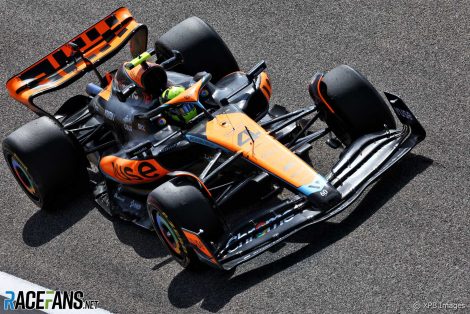McLaren will continue to run new digital advertising technology on their cars during race weekends in 2023 after the unique panels made their race debut in Bahrain.
Lando Norris and Oscar Piastri ran with dynamic digital advertising panels on their cars throughout the opening race weekend. Created by Seamless Digital, the flat, lightweight panels installed on the side of the MCL60’s cockpit underneath the halo dynamically cycle through logos and advertising messages.
After first testing the emerging technology during practice for the 2022 United States Grand Prix at Circuit of the Americas, McLaren installed the panels for all three practice sessions, qualifying and the race over the Bahrain Grand Prix weekend.
The panels use technology similar to those used in e-reader devices like Kindles, allowing multiple logos and graphics to be shown on the display and even be programmed to change in specific areas or situations using the car’s existing controller area network (CAN) bus system. The two-panel set-up weighs just 190 grams and McLaren claims they have a negligible aerodynamic impact when installed.

The CEO of inventors Seamless Digital, Mark Turner, said the technology has received multiple revisions during development until it was ready to be including on active race cars.
“We want to make sure that our product is enhancing a race team,” Turner said. “We have tirelessly iterated the system to reduce the total mass to F1 levels of performance.
“We want to be a net positive to McLaren, the sport and F1 followers. As a tool for teams and sponsors, we can’t wait to see the marketing creativity it fuels but we will also ensure that it remains a discerning product with high performance engineering at the heart.”
Advert | Become a RaceFans supporter and
McLaren design engineer Spencer Busby said the team tested the technology extensively until it was fully satisfied it could be installed without any compromise to weight, aerodynamics or performance.
“Testing of the panels started towards the end of the 2021 season and continued through the beginning of 2022,” Busby explained.
“The technology ran as an isolated, self-powered installation, mounted on a piece of bodywork, and covered in vinyl so as not to gain attention on-track. The testing allowed us to ensure that the weight of the system was reduced to an absolute minimum, the panels aligned accurately and had no adverse effects on aerodynamics….
Click Here to Read the Full Original Article at RaceFans…
